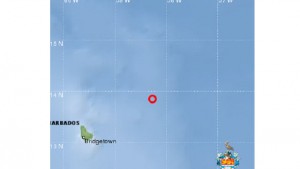
A UWI Seismic Research Centre map showing the location of the larger of the two tremors.
BRIDGETOWN, Barbados, Friday July 17, 2015 – As most people slept last night and into this morning, two more tremors were recorded off Barbados, St. Lucia and Martinique, following six events over a six-hour period yesterday.
Preliminary information provided by the UWI Seismic Research Centre indicated that the quakes were recorded a minute past midnight, and then at 3:44 a.m.
The first was a 4.0 magnitude tremor occurring 170 km northeast of Bridgetown, Barbados; 301 km east of Castries, St. Lucia and 322 km east southeast of Fort-de-France, Martinique.
The second was weaker – 3.8 magnitude – with its epicenter 119 km northeast of Bridgetown, 236 km east of Castries, and 259 km east southeast of Fort-de-France.
They came hours after acting director of the Department of Emergency Management in Barbados Kerry Hinds told residents that there was a possibility that aftershocks would continue in the coming days.
Barbadians and residents of neighbouring St. Lucia, Dominica, St. Vincent, Trinidad and Tobago, Martinique, Guadeloupe and even Guyana reported feeling the effects of yesterday’s earthquakes, particularly the first 5.7 magnitude tremor which struck at 7:01 a.m. and the most intense one of the day – 6.4 magnitude quake which sent people scampering from shaking buildings around 11:16 a.m.
In a report on the day’s events, the Seismic Research Centre said there were four others – at 7:52 a.m., 11:29 a.m., 11:36 a.m. and 12:23 p.m.
The magnitudes of the day’s quakes ranged from 3.4 to 6.4 and their depths from 61 km to 111 km.
There were no reports of damage or injury.
Executive Director of the Caribbean Disaster Emergency Management Agency, Ronald Jackson said the earthquakes underscored the importance of building national first responder capacity to manage seismic events.
“We have to recognize that the earthquake threat is ever present. We have been heeding the warning from the Seismic Research Centre from as far back as February 2014 when a number of events . . . really underscored the importance that we have to move at pace. It is now a situation of urgency that we address the capacity of our first responders, given the catastrophic nature that seismic events can leave us with,” he said.
